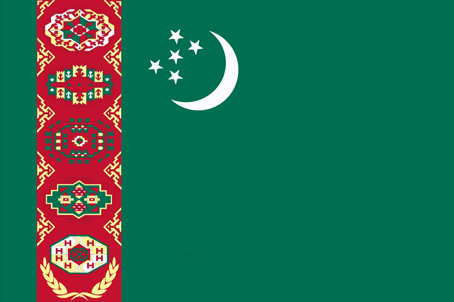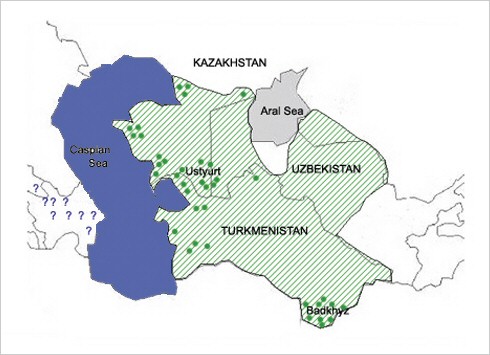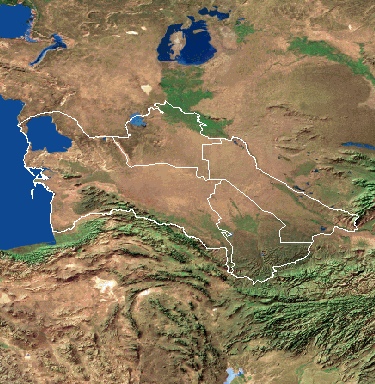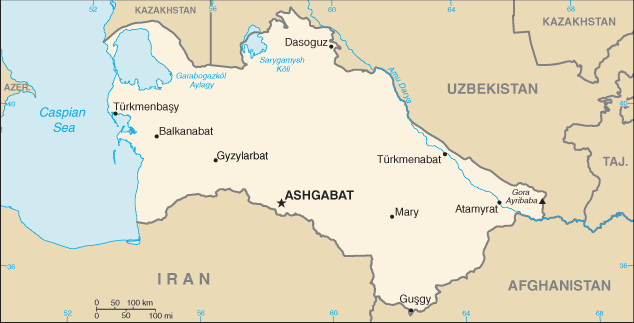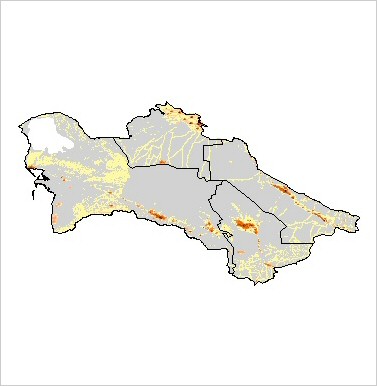|
|
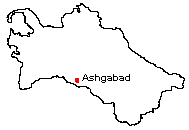 |
| |
back to top | ||
| The
Asiatic cheetah (Acinonyx jubatus venaticus)
persisted in Turkmenistan until the late 1970s. There
are some unconfirmed reports from the 1980s and even
in the 1990s for the Ustjurt Plateau in the north of
the country, but all authors consider the cheetah to
be extinct today.
Map from Mallon (2007): Reconstructed range of the cheetah in Central Asia (adapted from Bannikov 1984).The former distribution is indicated in green hatching and specific localities as green dots; probable range in Transcaucasia in the 17th-18th centuries as question marks. |
|
||
|
|
|||
|
|||
|
Background: Annexed by Russia between 1865 and 1885, Turkmenistan became a Soviet republic in 1924. It achieved its independence upon the dissolution of the USSR in 1991. Extensive hydrocarbon/natural gas reserves could prove a boon to this underdeveloped country if extraction and delivery projects were to be expanded. The Turkmenistan Government is actively seeking to develop alternative petroleum transportation routes in order to break Russia's pipeline monopoly. President for life Saparmurat NIYAZOV died in December 2006 and Turkmenistan held its first multi-candidate presidential electoral process in February 2007. A former NIYAZOV aide, Gurbanguly BERDIMUHAMMEDOV emerged as the country's new president. |
|||
| |
back to top |
|
Area: total: 488,100 km2 Climate: subtropical desert Terrain: flat-to-rolling sandy desert with dunes rising to mountains in the south; low mountains along border with Iran; borders Caspian Sea in west Natural resources: petroleum, natural gas, sulfur, salt Land use: arable land: 4.51%; permanent crops: 0.14%; other: 95.35% (2005) Irrigated land: 18,000 sq km (2003) Environment - current issues: Contamination of soil and groundwater with agricultural chemicals, pesticides; salination, water-logging of soil due to poor irrigation methods; Caspian Sea pollution; diversion of a large share of the flow of the Amu Darya into irrigation contributes to that river's inability to replenish the Aral Sea; desertification. Environment - international agreements: party to: Biodiversity, Climate Change, Climate Change-Kyoto Protocol,
Desertification, Hazardous Wastes, Ozone Layer Protection Geography - note: landlocked; the western and central low-lying, desolate portions of the country make up the great Garagum (Kara-Kum) desert, which occupies over 80% of the country; eastern part is plateau |
|
|
|
|
|
|
|
|
|
|
| |
back to top |
|
Population: 5,042,920 (July 2006 est.) Age structure: 0-14 years: 35.2% (male 913,988/female 863,503),
15-64 years:
60.7% (male 1,501,486/female 1,557,155) Median age: total: 21.8 years,
male: 20.9 years,
female: 22.7
years Population growth rate: 1.83% (2006 est.) Infant mortality rate: total: 72.56 deaths/1,000 live births, male: 76.9 deaths/1,000 live births, female: 68 deaths/1,000 live births (2006 est.) Life expectancy at birth: total population: 61.83 years, male: 58.43 years, female: 65.41 years (2006 est.) Total fertility rate: 3.37 children born/woman (2006 est.) HIV/AIDS - adult prevalence rate: less than 0.1% (2004 est.) HIV/AIDS - people living with HIV/AIDS: less than 200 (2003 est.) HIV/AIDS - deaths: less than 100 (2003 est.) |
|
|
Ethnic groups: Turkmen 85%, Uzbek 5%, Russian 4%, other 6% (2003) Religions: Muslim 89%, Eastern Orthodox 9%, unknown 2% Languages: Turkmen 72%, Russian 12%, Uzbek 9%, other 7% Literacy: definition: age 15 and over can read and write; total population: 98.8%; male: 99.3%; female: 98.3% (1999 est.) |
|
| |
back to top |
|
Data Code: TM Government type: republic; authoritarian presidential rule, with little power outside the executive branch Independence: 27 October 1991 (from the Soviet Union) Legal system: based on civil law system Political pressure groups
and leaders: Democratic Party of Turkmenistan or DPT |
|
| |
back to top |
|
Economy - overview: Turkmenistan is a largely desert country with intensive agriculture in irrigated oases and large gas and oil resources. One-half of its irrigated land is planted in cotton; formerly it was the world's tenth-largest producer. Poor harvests in recent years have led to an almost 50% decline in cotton exports. With an authoritarian ex-Communist regime in power and a tribally based social structure, Turkmenistan has taken a cautious approach to economic reform, hoping to use gas and cotton sales to sustain its inefficient economy. Privatization goals remain limited. In 1998-2005, Turkmenistan suffered from the continued lack of adequate export routes for natural gas and from obligations on extensive short-term external debt. At the same time, however, total exports rose by an average of 15% per year in 2003-06, largely because of higher international oil and gas prices. In 2006, Ashgabat raised its natural gas export prices to its main customer, Russia, from $66 per thousand cubic meters (tcm) to $100 per tcm. Overall prospects in the near future are discouraging because of widespread internal poverty, a poor educational system, government misuse of oil and gas revenues, and Ashgabat's unwillingness to adopt market-oriented reforms. Turkmenistan's economic statistics are state secrets, and GDP and other figures are subject to wide margins of error. In particular, the rate of GDP growth is uncertain. President BERDYMUKHAMMEDOV's election platform included plans to build a gas-line to China, to complete the AmuDarya railroad bridge in Lebap province, and to create special border trade zones in southern Balkan province - a hint that the new post-Niyozov government will work to create a friendliery foreign investment environment. GDP - real growth rate: IMF estimate: 13% GDP - composition by sector: agriculture: 24.4%; industry: 33.9%; services: 41.7% (2006 est.) Labor force: 2.32 million (2003 est.) Labor force - by occupation: agriculture: 48.2%; industry: 13.8%; services: 37% (2003 est.) Unemployment rate: 60% (2004 est.) Population below poverty line: 58% (2003 est.) Agriculture - products: cotton, grain; livestock Industries: natural gas, oil, petroleum products, textiles, food processing Industrial production growth rate: 22% (2003 est.) Exports: $5.421 billion f.o.b. (2006 est.) Exports - commodities: gas, crude oil, petrochemicals, cotton fiber, textiles) Exports - partners: Ukraine 42.8%, Iran 14.8%, Hungary 5.3% (2005) Imports: $$3.936 billion f.o.b. (2006 est.) Imports - commodities: machinery and equipment, chemicals, foodstuffs Imports - partners: UAE 12.7%, Azerbaijan 11.1%, US 9.6%, Russia 9.1%, Ukraine 7.6%, Turkey 7.3%,
Iran 6.2%, Currency (code): Turkmen manat (TMM) Exchange rates: 11,100 (2006) |
|
| back to top | |||
|
Telephone system: general assessment: poorly developed Radio broadcast stations: AM 16, FM 8, shortwave 2 (1998) Television broadcast stations: AM 16, FM 8, shortwave 2 (1998) Internet country code: .tm Internet hosts: 585 (2006) Internet users: 36,000 (2005) |
|||
|
|
|||
|
|||
|
Breitenmoser U. 2002. Feasability study of cheetah reintroduction in Turkmenistan. Cat News 36, 13-15. Mallon D. 2007. History of cheetahs in Central Asia. Cat News 46, 4-7. http://www.lib.utexas.edu/maps/turkmenistan.html https://www.cia.gov/cia/publications/factbook/geos/ag.html http://en.wikipedia.org/wiki/turkmenistan |
